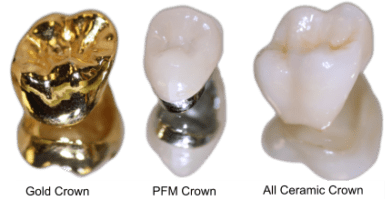- Dental Implant Pain Causes and Best Treatments - September 15, 2020
- Clinic Brings Brighter Smiles to Local Faces - April 30, 2019
- Top 10 Wisdom Tooth Removal Clinics in Your City - March 28, 2019
A ‘dental crown’ also known as ‘dental cap’ is a dental restoration employed by a dentist to protect a part of a tooth or the whole gum line. It is a dental insertion which is placed on the top of the gum like a cap and becomes a part of the mouth cavity.
Crowns and bridges are known as “prosthetic devices” in Dentistry while in ordinary layman’s language these are artificial covers that dentists implant in the jawline to restore the teeth to its normal condition.
Functions of Dental Crowns
The American Dental Association (ADA) has given guidelines on the uses of dental crowns, and the dentist handles the situation according to the particular dental needs of the patient.
Repair
A crown is placed over a tooth that is badly stained and/or takes an unattractive shape. In order to hide these imperfections, a crown is used to amend how a tooth is positioned and to give a continuous orientation to all the teeth in the mouth.
Strengthen Teeth
A dental crown is also used to strengthen a broken tooth and makes it stable again. This is done by placing the crown over the tooth to hold it firmly. A perfectly fixed crown goes a long way to protect against tooth decay.
Cosmetic Uses
A dental crown enhances the appearance of a tooth or a set of teeth. In other words, the colour, form and even the orientation of a tooth or teeth are accurately aligned with the help of a dental crown. A dentist can recommend a dental crown to replace a big insertion or to replace some lost teeth.
Types of Crown 
There are basically four types of crowns available for use in the dental profession and practice. These are based on the type of material used in their formation.
Porcelain Crown
Porcelain crowns easily mix and tie with the precise colour of your teeth and are also most valued as compared to the other materials. They are also known to be well-suited to the human body, in terms of being harmless.
Ceramic Crown
This kind of crown is usually used to repair front teeth. They are widespread in all parts of the world because they become an easy match of the natural colour of your teeth. Ceramic crowns are made with the porcelain-based material and are not as durable as metal crowns.
Metal Crown
Although metal crowns are thinner than porcelain crowns yet they can better endure chewing activities. They are also easier to fix on a tooth because less material is required to be removed from teeth for its placement.
Combination Crowns
The last type of dental crowns is a combination of porcelain bonded with metal crowns. This is the best form of the dental crown because it maintains the beauty of the porcelain and still utilizes the strength of the metal crown.
Conditions When You Need a Crown
Damaged Teeth
A person who has a severely damaged tooth or who has lost some teeth would necessarily need a dental crown. Adults can never expect that their broken or lost teeth would heal up or grow again.
Decaying Teeth
Sometimes people get their tooth filled with a silver filling, which could reshape the teeth set up, leading to a need to place a crown over them. A dental crown will protect other teeth from being contaminated and suffer the same fate as the decayed ones. In other words, a dental crown could prevent future dental complications and in some cases will be a better option than a tooth filling.
Recommendation by Your Dentist
Dentists sometimes recommend dental crowns for those who are likely to suffer future teeth injury, especially those who have received teeth cavity surgery previously. A dentist could envisage that someone is at risk of getting his tooth or teeth damaged in future, especially those with the cross-jaw syndrome.
Change of Appearance
If a person wants a different appearance of their teeth, a dental crown will fulfil this desire. They can be framed according to the customized needs and can last longer as well.
Temporary and Permanent Crowns
- Temporary dental crowns are those which can be quickly fitted to a tooth (in six to fifteen minutes). They are usually made of acrylic material, aluminium, and typically do not last long.
- Permanent crowns, on the other hand, are the conventional type of crowns which are made to fit into any teeth on permanent or long-term bases. The permanent crowns are usually made with porcelain combined with metal.
Dental Crown Procedure
First Dentist Visit: The process begins on your first visit to the dentist, who could have an x-ray done to determine the magnitude of your dental problems (tooth and jawbone x-ray investigation). This is to ascertain if there are signs of tooth damage and decay or if there are conditions that could put you at risk of infection or harm. The dentist can remove some material from the teeth to make space for the crown.
There are cases where crowns are formed in the clinic so that it could be placed on the same day.
Second visit: Meanwhile, the dentist will send your dental impression to the technician or in the laboratory so that a crown can be structured according to the shape of your teeth and gum line.
This dental personnel, usually a dental technician, forms the crown to be used on you in the correct way. The process lasts up to three weeks and gives your dentist time to place a dental crown accurately.
Step 1
Your dentist needs to examine your teeth before you proceed about a dental crown. This examination will determine your need for a crown or otherwise. Your visit to your dentist will also enable you to choose that what material you need for the dental crown as each type of material has their peculiar advantages and disadvantages. The selection of material also depends on your level of affordability.
Step 2 
The dental laboratory that forms your dental crown needs correct prototypes of both your maxillary and mandibular curvatures, in order to design a suitable crown for your tooth. If you have selected a full ceramic or porcelain fused to metal crown (PFM), your dentist will need the particular shade of your tooth before he begins the preparation of the tooth.
Usually, the dentist trims the tooth and does not need to cut the gums. However, he will reshape the tooth to be low enough to fix the crown properly.
Step 3 
Once the jaw gets anaesthetized, the dentist would assess the proper placement of the long-lasting crown. During your next appointment, the dentist will get your mouth ready to receive the crown. After the crown is fixed, the dentist will get you to examine it to ensure that it appears good and that you’re satisfied with it. Thereafter, the dentist will fix the crown permanently.
Does Dental Crown Procedure Hurt
Having a dental crown fixed on you should not give you any pain. Local anaesthesia will be given to patients to ensure that there is no more pain before your dentist begins to work on your tooth. You could also be given short breaks to relax your mouth your jaw.
Gold crown cost (in US Dollar)

The quantity of gold used in making a crown determines how costly it will be. This type of crown is priced between USD 1,000 and USD 1,400.
Ceramic Crown Cost
The cost of dental treatments varies from country to country, and according to the area of the same country where the treatment is given. Usually, prices differ from city to city, even in the same country. However, it’s Price can range from USD 800 to USD 3000.
Porcelain Crowns Cost
Just like ceramic crowns, the price of Porcelain crowns fluctuates from one area to another. However, a rough price estimate is from $600 to $3000.
Dental Crown Cost in Different Countries
| Country | Dental Crown Cost ($) |
|---|---|
| U.S.A | 500 - 1600 |
| United Kingdom | 300 - 1500 |
| Canada | 500 - 1500 |
| Germany/Europe | 200 - 800 |
| Australia | 700 - 1500 |
| New Zealand | 300 - 1000 |
| India | 100 - 500 |
| Dubai | 300 - 1500 |
| South America | 300 - 3000 |
| Malaysia | 424 - 1500 |
| China | 300 - 1500 |
| Philippines | 100 - 500 |
| South Africa | 300 - 1000 |
| Pakistan | 100 - 400 |
How Long Does a Crown Last

Most of the time, dental crowns on the front teeth last for 15 years. On the other hand, some crowns last nearly 30 years. Recent researches reveal that the typical lifetime of all front teeth dental crowns is 94percent in the early 5 years, and 90percent for the remaining 10 years. Whether porcelain on metal, gold, or all porcelain, dental crowns do not deteriorate, though this does not mean that neglecting your teeth would not lead to tooth decay. How well you keep your tooth free of dental plaque, determines how long a crown would last.
Visit Nearby Dental homepage to read more about other treatment options available for you.




